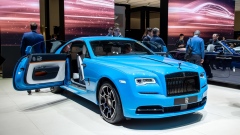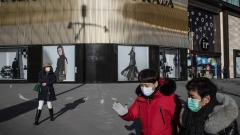Dec 6, 2021
Trends at Art Basel Miami Beach That Could Spill Into Next Year
, Bloomberg News
(Bloomberg) -- There are three primary ways galleries source work for an art fair booth.
The first is to get it from an artist the gallery represents. The second is to draw on the gallery’s own inventory. The third is via consignment, which is when the owner of an artwork gives it to a dealer, who then takes a commission from the sales price.
Like nearly every art fair before it, the galleries exhibiting at Art Basel Miami Beach brought work acquired through a combination of all three channels, meaning that the art on view wasn’t just what was available, it was what insiders thought the market wanted most.
And so, despite the fact that 253 galleries together had thousands of artworks worth many millions of dollars to sell, there were some clear indications of the current state of the contemporary art market—as much for what was not on offer as for what was.
Maybe a Picture Doesn’t Last Longer
Contemporary photography has traditionally been an entry point for nascent collectors, both because of its accessibility and a price point that is often lower than painting and sculpture. This year, there wasn’t a lot for the fair’s 60,000 attendees to choose from.
“I even had a client who mentioned that,” says the adviser Heather Flow. “They said, ‘When we first started collecting, we bought so much photography, and there’s not much here this year.’”
Maybe it was just a question of shifting tastes. Possibly it had something to do with filling the wall space of collectors’ fourth or fifth houses. Perhaps it was because everyone, stuck on computers throughout the Covid-19 pandemic, craved something with texture.
“We’ve all been living in a flatscreen world,” says Flow. “The flat, compressed image—which is the way photography can sometimes feel like—maybe it’s too reminiscent of having everything on the screen.”
The fitful markets of the medium’s biggest stars certainly aren’t helping.
In recent years, Cindy Sherman, Andreas Gursky, and Jeff Wall have seen their markets sink at auction, both in price and volume; their diminished market power could have a dampening effect on that of other contemporary photographers.
The flip side could also be true: Dealers, flush from a year of sold-out shows and record demand, seemed to bring a much higher caliber tranche of material than in years past, leaving lower-priced art at home.
“Underlying the entire fair was this idea that no one knows what 2022 is going to be like,” Flow says. “I think people were bringing whatever they knew they could sell and whatever they could sell for high numbers. Because if they have the cash now, they can plan for 2022.”
No Screens
For all the talk of NFTs breaking into fine art, there was barely any digital art in the fair itself.
That could be because NFT projects elsewhere were sucking the air from the room, and dealers didn’t want to compete; last week in Miami there were literally hundreds of NFT-related events, including NFT conferences, NFT panel discussions, NFT sales, NFT boat parties, and, of course, NFT exhibitions.
Or it could be that the confusion around NFTs—not to mention much of the art world’s distaste for the field—caused traditional galleries to steer clear of anything that even hinted of an association with the trend.
The only notable exception was at Pace Gallery, which offered an NFT by the Drift artists Lonneke Gordijn and Ralph Nauta; it sold for $500,000 (plus a $50,000 donation added by the purchaser) on the second day of the fair.
Everywhere else, very few screens could be found. Digital art as a medium “has been particularly obsolete, except for in the NFT realm,” says the adviser Lisa Schiff. “It’s been on the downside for a while.”
A Market in Transition
So what was selling?
As in the past five years, at least, figurative painting of non-White people by non-White artists continues to do well.
The November auctions in New York that preceded the fair saw spectacular results for work in the category—a 2019 painting by Amoako Boafo sold for $441,000 at Sotheby’s over a high estimate of $150,000, for instance, and a 2012 painting by Amy Sherald sold for $3.9 million over a high estimate of $1.8 million at Phillips.
Often, an artist’s auction success in November translates to a profusion of their work in Basel in December. “Sometimes, you go down and you can see all the things that recently sold at auction,” says Flow. This year, “it didn’t feel like that,” she says.
Indeed, a careful look at the booths in Miami revealed a transition away from figuration altogether. “You can see the beginning of the end of painterly, figurative paintings,” says Schiff.
Momentum ranged from the very high end, such as a 1953 abstract painting by Ad Reinhardt that sold for more than $7 million at David Zwirner, to more affordable price points, including a ceramic sculpture by Masaomi Yasunaga at Lisson Gallery that sold for $10,000.
“Seeing what was brought, it’s more conceptual and abstracted. Instead of art thinking in the now, it’s thinking in the future,” Flow says.
She cites McArthur Binion, whose complex abstract work was featured in Lehmann Maupin and Gray galleries’ booths; Fred Eversley, a former engineer whose colorful, cast-polyester sculptures were in the booths of David Kordansky and Nicola Vassell; and Tetsumi Kudo, the late Japanese artist whose challenging, detailed sculptures were on view at Galerie Christophe Gaillard.
This isn’t to say that we’ve returned to the era of ungainly Kunsthalle-specific installations, “but we’re starting to shift back to other things,” Schiff says. “It’s still beautiful art, but it’s more conceptual.”
©2021 Bloomberg L.P.


